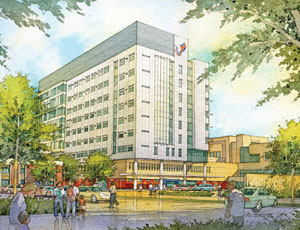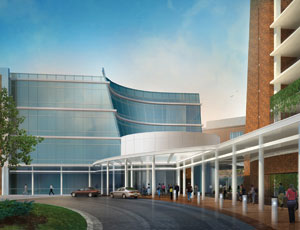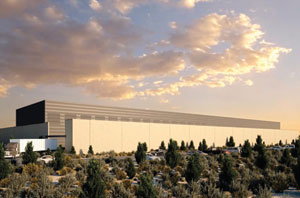



1. Oregon State Hospital Replacement - Salem
PROJECT COST: $280 Million
Started: July 2008
Target Completion: Late 2011
Owner: Oregon Dept. of Human Services
Design Firm: HOK; SRG Partnership
General Contractor: Hoffman Construction Co.
Construction Manager: CH2M HILL
Engineers: KPFF; Westlake Consultants; AEI
Subcontractors: Konell Construction; Demolition Corp.; Cherry City Electric; Oregon Cascade Plumbing & Heating; Dallas Glass; Davidson Masonry
This project brings the long-awaited replacement of Oregon’s 127-year-old state hospital in Salem. New construction includes a three-story, structural steel building to house patient housing, staff offices, treatment rooms and recreation areas. The historic J building will be partially demolished, with some parts being restored. Once complete, the hospital will house 620 beds within 800,000 sq ft. A second hospital with a capacity of 360 beds is scheduled to open in Junction City in 2013 under a separate construction contract.
2. The Children�s Hospital at Emanuel Medical Center
PROJECT COST: $250 Million
Started: August 2009
Target Completion: Fall 2011
Owner: Legacy Health
Design Firm: ZGF Architects LLP
General Contractor: Hoffman Construction
Engineers: Sparling; CDi; Catena Consulting Engineers
Subcontractors: Fought & Co.; Oregon Electric Group; Electrical Constr. Co.; JH Kelly LLC; Temp Control Mechanical
This nine-story, 300,000 sq-ft tower plus 425-space parking structure in Portland is designed exclusively for the special health care needs of children, with a 22-room emergency department separate from adult patients. Another 22 beds are reserved for a children’s day surgery unit. A new Neonatal Intensive Care features 31 single private rooms, and 7 double private rooms for twins. The project cost includes medical center capital improvements.
3. Kaiser Permanente Westside Medical Center
PROJECT COST: $210 Million
Started: August 2009
Target Completion: Spring 2012
Owner: Kaiser Westside Medical Center
Primary Architect: Ellerbe Becket
Associate Architect: PKA
General Contractor: Andersen Construction
Engineers: Catena Consulting Engineers; Mazzetti Nash Lipsey Burch; WHPacific
Subcontractor: The Erection Co.
This new LEED-gold hospital, located in Hillsboro, is highlighted by a 289,762-sq-ft, four-story structure housing a combined 128-bed hospital with a diagnostics and treatment building with a nursing tower. The steel-framed structure links to an adjacent 110,000-sq-ft hospital support building, a five-story, steel-framed structure that will welcome patients and visitors via a grand entry rotunda. An adjacent 915-space parking structure will include green screen treatment on the façade plus 1.5-story serpentine brick screen walls.
The entire campus will be supported by a new 30,000-sq-ft structural steel framed central utility plant.
4. Prineville Data Center
PROJECT COST: $188 Million
Started: January 2010
Target Completion: January 2011
Owner: Facebook.com
Design Firm: Sheehan Partners
General Contractor: DPR Construction Inc. / Fortis Construction Inc. – A Joint Venture
Subcontractors: R.F. Stearns Inc.; Rosendin Electric; Marion Construction; Western States Fire Protection; Fab-Tech LLC
The 147,000-sq-ft custom data center in eastern Oregon is needed to provide storage space for the massive amounts of photos, video and data generated by Facebook users worldwide.
The facility maximizes energy efficiency through an evaporative cooling system that will be operated up to 70% of the year when humidity is low. A portion of the heat generated by the project’s thousands of servers will be captured and re-used to heat office spaces. Pursuing LEED gold certification, the project’s other features include the use of rainwater for landscaping, low-VOC finishes and low-flow fixtures.


Post a comment to this article
Report Abusive Comment